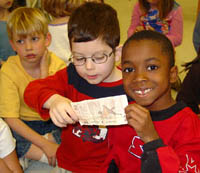|
Evaluating the Process
| Assessing Your Students' Online Work |
 You and your partner teacher have designed your online project or activity, matched it with your content standards and the students are aware of the project goals. As your project progresses you and your students as well as your partner class will be assessing what is taking place both for them and for you. Assessment should take place during your project as well as when the project is complete.
You and your partner teacher have designed your online project or activity, matched it with your content standards and the students are aware of the project goals. As your project progresses you and your students as well as your partner class will be assessing what is taking place both for them and for you. Assessment should take place during your project as well as when the project is complete.
Questions to keep in mind:
- Are the students following the activities as planned?
- Are they completing their tasks?
- Are they learning from their mistakes?
- Are they satisfied with their progress?
- What is working best for you?
- Is your partner class participating as you planned?
- Would you do anything differently next time?
- Are your goals reasonable?
- What obstacles are providing a challenge?
- To whom can you go for help?
- Is technology stretching your students to reach new goals that would otherwise not be possible?
Is anybody learning anything? Does technology make a difference? Teachers, administrators, parents, taxpayers have a right to know. We can reassure them all by providing evidence that justifies the funding spent on technology.
When assessing student work you may want to consider using various forms of assessment such as journals, portfolios, performance assessments using rubrics, oral reports, musical presentations, plays, etc. The Miami Museum of Science describes various forms of alternative assessments.
More readings on assessment:
- Emerging from the Smog:
Making Technology Assessment Work for Schools by Jamie McKenzie
- Kathy Schrock's Guide for Educators - Assessment Rubrics
- Chicago Public Schools Performance Assessment Ideas and Rubrics
- Chicago Public Schools The Rubric Bank
- Rubrics for Web Lessons - Nancy Pickett
From a Maryland Consortium Task:
- Sample rubrics for Line graphs
- Sample rubrics for Circle graphs
- Sample rubrics for Reading
- Sample rubrics for Language Usage
- Sample rubrics for Writing
| Designing Assessment Rubrics |
As you design your project, you will have learning outcomes and objectives in mind. Your assessment rubric or scoring guide will address these outcomes. Be sure to:
- Identify the learning outcomes and the important dimensions of each skill.
- Evaluate things you can measure.
- Write descriptions of various stages of development for each skill.
- Assign points for each stage.
- Keep your points of equal weight between the rubric scale. The difference between 1 and 2 should be the same as between 2 and 3.
- Make sure your rubric is practical and well defined.
- Design a concise rubric that will fit on one sheet of paper.
- Edit and refine your rubric as needed.
A sample template for building rubrics is given below.
Learning outcomes: Students in grade 6 established keypal friends and responded faithfully to their messages. The students used correct grammar and sent messages that demonstrated additional thought and effort. Students and their keypals discussed topics that went beyond usual keypal conversation and grew in multicultural awareness.
A sample scoring rubric has been started below. The rest of the chart would be filled in to reflect your identified learner outcomes for the activity. Once the classroom teacher is comfortable when designing this kind of rubric he/she can invite the students to have input. It is important for the students to know in advance how their work will be assessed. Always evaluate your rubrics and change them if necessary.
Scoring Rubric for Gathering and Analyzing Weather Data
| Learning Outcome |
0 points |
1 point |
2 points |
3 points |
Total |
| Student responded to his/her keypal within a week. |
Very few responses were sent |
Replies were sent but generally late and with only a minimal number of lines. |
Replies were sent within a week and all questions were answered |
All messages were answered right away and in addition to answering questions from the keypal, the student commented on something the sender said. |
|
|
|
|
|
|
|
|
|
|
|
|
|
|
|
|
|
|
|
|
|
|
|
|
|
Total
|
|
Rubrics take time to write so be sure to save each rubric. You may find that you can use pieces of rubrics when designing new ones.
Back to the Menu
|
 You and your partner teacher have designed your online project or activity, matched it with your content standards and the students are aware of the project goals. As your project progresses you and your students as well as your partner class will be assessing what is taking place both for them and for you. Assessment should take place during your project as well as when the project is complete.
You and your partner teacher have designed your online project or activity, matched it with your content standards and the students are aware of the project goals. As your project progresses you and your students as well as your partner class will be assessing what is taking place both for them and for you. Assessment should take place during your project as well as when the project is complete.